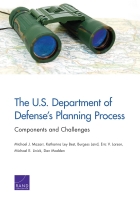by Michael J. Mazarr
Research Questions
 How many and what types of forces (and ground, air, sea, space, cyber, and other capabilities) are called for, and why?
How many and what types of forces (and ground, air, sea, space, cyber, and other capabilities) are called for, and why?
What size and composition of force would best equip the Joint Force and, in particular, the Army to meet the set of demands presented by the security environment and the mission set outlined in defense strategy documents?
By what objective standard can the leaders of the U.S. defense enterprise be confident that the force they choose is best aligned with U.S. strategy and policy goals?
This report — Phase Two of a three-phase project — explores the current defense planning process used by the U.S. Department of Defense (DoD), with a focus on how scenarios are developed and employed to support defense planning. The authors examine and critique how scenarios are used in current planning processes, based on an assessment of unclassified documents and dialogues with current and former participants in the process. They find that the process is structurally sound but insufficiently flexible. In theory, many opportunities, methods, and means exist to respond to a changing security environment. However, in practice, the layers of approval required for new concepts, lengthy intradepartmental coordination, exhaustive detail required for the preferred formal modeling, and the resource-intensiveness of the entire process — even as headquarters shrink — often make the system unable to generate new scenarios and concepts for an area of interest in a timely manner. Instead, DoD ends up with a single new authoritative scenario — a point solution rather than an exploration of the many policy-relevant differences that might affect how a conflict unfolds. Just as important, the process both obscures critical uncertainties and smothers innovation. The process tends to be unwelcoming to innovative or controversial ideas or initiatives that might further delay decisions about the new "canonical" scenario still further. This process can work during times of continuity (scenario diversity is developed over several years) — but, during times of sudden discontinuity, it seriously reduces DoD's responsiveness. The authors offer recommendations to address these challenges.
Key Findings
The defense planning process uses scenarios for a range of purposes, complicating selection criteria
Defense strategic guidance uses scenarios to create a list of generic capabilities. However, any given set of capabilities required in one scenario may be vastly different in scale and composition than the capabilities used in another scenario.
The primary challenges in using scenarios reside in their practical implementation, not in the overall structure of the process
The current process pays significant attention to the choice of assumptions, but it lacks time and resources to adequately explore the implications of these assumptions.
There are any number of potential wars the United States could fight, and the compound probability of some of them occurring simultaneously is rarely seriously examined. Therefore, choosing to size or prepare for any combination of scenarios involves guesswork rather than meaningful strategic judgment.
The quality and utility of the process are functions of strong senior leadership engagement and commitment.
The process of narrowing down to a handful of force planning scenarios can be subjective and arbitrary
Senior defense leaders are understandably preoccupied with the challenges immediately in front of them and generally less interested in thinking about long-range or out-of-the-box scenarios.
The assessment of scenarios has become so exhaustive and inflexible that it constrains the responsiveness of the overall process
The employment of scenarios in support of defense planning is not in need of a radical overhaul, but important improvements need to be made to enhance its credibility, agility, and robustness.
Recommendations
It is easy to become focused on the details of the process, but the ultimate metric for success is whether the system is producing compelling stories that convey the full range of current and potential threats and gaps in U.S. capabilities to deal with them, and whether the scenarios provide useful and timely analysis to inform the defense planning process.
DoD could benefit from placing greater emphasis on nonstandard scenarios rather than focusing energy on long-term deliberate planning for one or two expected ones.
Scenario-building and assessment must include detailed consideration of assumptions, including sensitivity analysis.
Slow responsiveness and lack of flexibility are among the greatest impediments to a more-effective and responsive defense planning process.
The process should explore a broader set of low-fidelity scenarios to hedge against surprise.
The process should also explore current scenarios with a focus on innovation.
The current process is not as responsive as it could be because it is not designed to anticipate scenarios that could emerge at some future point; it should prioritize beyond the force-sizing construct.
Acknowledging assumptions is not enough — they must be assessed. A revised process could take the assumption phase more seriously. It could subject assumptions to rigorous analysis and debate and force the system to take seriously the implications of its conventional wisdom. It also could inform this discussion with a more-detailed estimate of the relationship between specific assumptions and outcomes.
No comments:
Post a Comment